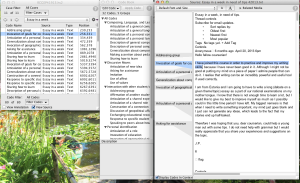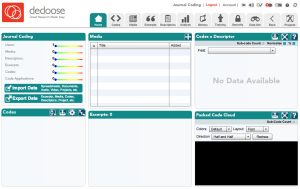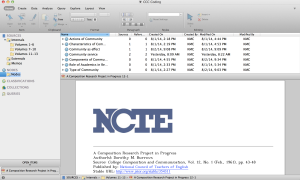I’m facilitating a teaching talk today on digital rhetorics for Women in Technical Communication. Join our Google Hangout at 11am EST/10am CDT for a conversation on the what, the whys, and the hows of integrating digital rhetorics into classrooms.
Here are some of the questions and topics we’ll cover:
Session Goal Setting
- As individuals and as a collective, what are our goals in discussing digital rhetorics? What do we want to happen from this session, and how will we make that happen?
- As individuals and as a collective, what are our goals for digital rhetorics in our classes? What do we want to happen in our classes, and how will we make that happen?
Understanding Digital Rhetorics
- As individuals and as a collective, what is our understanding of digital rhetorics? How are we defining it, what does it entail?
Teaching Digital Rhetorics: Setting Goals, Outcomes, and Means
- What learning outcomes do we have for digital rhetorics?
- What do we want students to know or do with digital rhetorics (both generally or within the learning objectives of a specific class)?
- What are some digital rhetorics-related outcomes that you have incorporated into your class, and what would you share with others about that experience?
- What are some ways that we can meet these learning objectives for digital rhetorics (again, within a specific class or generally)?
- What do we as instructors need to know to successfully meet digital rhetorics learning outcomes?
- What concerns do we have about incorporating digital rhetorics learning outcomes into our classes? What are we most looking forward to about incorporating digital rhetorics learning outcomes into our classes?
- What resources are available to support instructors and/or students with these learning outcomes?
- What resources do we still need in to meet these learning outcomes?
- What are some means of incorporating digital rhetorics into your class have you employed before? What would you share with others about that experience?
I’ll be posting notes and resources from our discussion here after the chat.
Points of Interest from Discussion
- How can we integrate digital rhetorics (including multimodal and visual rhetorics) into standard curriculum that we have no control over?
- Consider how the digital rhetorics literacies/learning outcomes overlap with the learning outcomes for the curriculum to see if there are ways to meet the curriculum learning outcomes with a digital rhetoric approach
- Consider integrating digital rhetorics into small-scale assignments or activities that scaffold the required curriculum/assignment sequence (for example: a rhetorical analysis or redesign of the university website can take 1 class session and develop skills students may need to complete the required assignments)
- Don’t try to do too much at first; take a semester or two to figure out what students need and where digital rhetorics can included most effectively
- How can we integrate digital rhetorics into low- to no-tech classroom spaces?
- Drawing on Jody Shipka’s work, think about how multimodal composition can be brought into the classroom in no-tech ways
- Have students doodle, draw, use Play-doh, etc. in class; these are no-tech ways to engage students in visual and multimodal rhetorics
- How can we holistically assess digital rhetorics learning outcomes at multiple levels (individual, class, program)?
- What digital rhetorics learning outcomes should we prioritize in semester-long classes when there are multiple sets of learning outcomes (such as professional writing, community partners, etc.)?
Resources
Assignments, Activities, and Syllabi:
- “Starting an Epidemic: Producing Virality from a Rhetorical Framework” activity from Kaitlin Clinnin (includes activity prompt, instructor’s guide, and sample student work)
- Arts of Persuasion: Rhetorics in Digital Culture syllabus from Kaitlin Clinnin (syllabus for an survey rhetoric course that included Aristotelian rhetoric and cultural rhetorics through a digital rhetorics framework)
- Artist Statement prompt and video from Kaitlin Clinnin (based on Jody Shipka’s work)
Content
- Harlot of the Arts (online journal that publishes multimodal work that integrates rhetoric and popular texts)
- Sweetland Digital Rhetoric Collaborative (online space that includes a wiki, blogs, and relevant content on digital rhetorics)
- Digital Rhetoric: Theory, Method, Practice by Doug Eyman (recent text that theorizes digital rhetoric, accessible to undergraduate and graduate students, also available through Project Muse)
- White Space is Not Your Enemy by Rebecca Hagen and Kim Golombisky (recommended text for combining the why of design with the how)
- Writer/Designer by Kristin L. Arola, Jennifer Sheppard, and Cheryl E. Ball (short textbook that considers multimodal composition from a rhetorical foundation)
- The Non-Designer’s Design Book by Robin Williams (classic text on design principles)
Do you have resources, suggestions, or thoughts about how to incorporate digital rhetorics into communication and composing classrooms? Please share and I’ll update this list.


